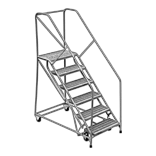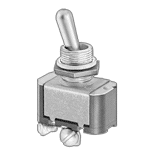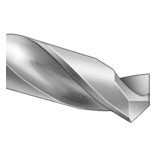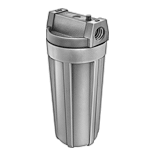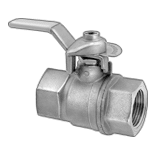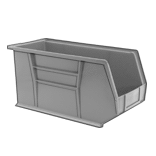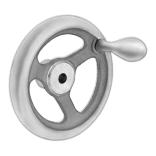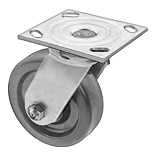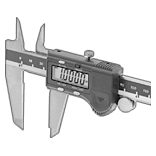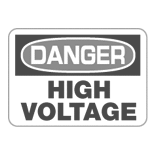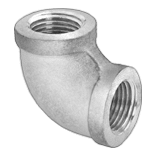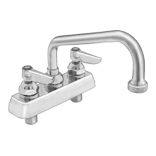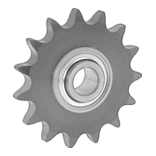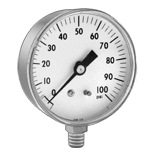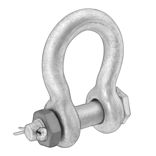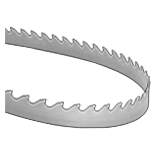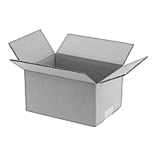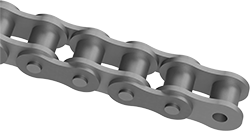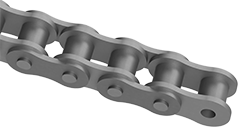Filter by
Roller Chain Trade Number
Component
Length
Chain Style
Roller Width
Roller Chain Type
Working Load
Roller Diameter
DFARS Specialty Metals
Export Control Classification Number (ECCN)
Specifications Met
Lubrication
Roller Chain and Links
Roller Chain | Chain | Connecting Links | Adding Links | Adding-and-Connecting Links | |||||||||||||||||||||||||||||||||||||||||||||||||||||||||||||||||||||||||||||||||||||||||||||||
|---|---|---|---|---|---|---|---|---|---|---|---|---|---|---|---|---|---|---|---|---|---|---|---|---|---|---|---|---|---|---|---|---|---|---|---|---|---|---|---|---|---|---|---|---|---|---|---|---|---|---|---|---|---|---|---|---|---|---|---|---|---|---|---|---|---|---|---|---|---|---|---|---|---|---|---|---|---|---|---|---|---|---|---|---|---|---|---|---|---|---|---|---|---|---|---|---|---|---|---|
Trade No. | Std. | Pitch | Roller Dia. | Roller Wd. | Working Load, lb. | Per Ft. | Each | Each | Each | ||||||||||||||||||||||||||||||||||||||||||||||||||||||||||||||||||||||||||||||||||||||||||
Single Strand | |||||||||||||||||||||||||||||||||||||||||||||||||||||||||||||||||||||||||||||||||||||||||||||||||||
Steel | |||||||||||||||||||||||||||||||||||||||||||||||||||||||||||||||||||||||||||||||||||||||||||||||||||
| 25 | ANSI | 1/4" | 0.130" | 1/8" | 140 | 00000000 | 00000 | 00000000 | 00000 | 00000000 | 00000 | 00000000 | 00000 | ||||||||||||||||||||||||||||||||||||||||||||||||||||||||||||||||||||||||||||||||||||||
| 35 | ANSI | 3/8" | 0.200" | 3/16" | 560 | 00000000 | 0000 | 00000000 | 0000 | 00000000 | 0000 | 00000000 | 0000 | ||||||||||||||||||||||||||||||||||||||||||||||||||||||||||||||||||||||||||||||||||||||
| 41 | ANSI | 1/2" | 0.306" | 1/4" | 500 | 00000000 | 0000 | 00000000 | 0000 | 00000000 | 0000 | 00000000 | 0000 | ||||||||||||||||||||||||||||||||||||||||||||||||||||||||||||||||||||||||||||||||||||||
| 40 | ANSI | 1/2" | 0.312" | 5/16" | 940 | 00000000 | 0000 | 00000000 | 0000 | 00000000 | 0000 | 00000000 | 0000 | ||||||||||||||||||||||||||||||||||||||||||||||||||||||||||||||||||||||||||||||||||||||
| 50 | ANSI | 5/8" | 0.400" | 3/8" | 1,620 | 00000000 | 0000 | 00000000 | 0000 | 00000000 | 0000 | 00000000 | 0000 | ||||||||||||||||||||||||||||||||||||||||||||||||||||||||||||||||||||||||||||||||||||||
| 60 | ANSI | 3/4" | 0.469" | 1/2" | 2,470 | 00000000 | 00000 | 00000000 | 0000 | 00000000 | 0000 | 00000000 | 0000 | ||||||||||||||||||||||||||||||||||||||||||||||||||||||||||||||||||||||||||||||||||||||
| 80 | ANSI | 1" | 0.625" | 5/8" | 4,290 | 00000000 | 00000 | 00000000 | 0000 | 00000000 | 0000 | 00000000 | 00000 | ||||||||||||||||||||||||||||||||||||||||||||||||||||||||||||||||||||||||||||||||||||||
| 100 | ANSI | 1 1/4" | 0.750" | 3/4" | 6,600 | 00000000 | 00000 | 00000000 | 0000 | 00000000 | 0000 | 00000000 | 00000 | ||||||||||||||||||||||||||||||||||||||||||||||||||||||||||||||||||||||||||||||||||||||
| 120 | ANSI | 1 1/2" | 0.875" | 1" | 8,870 | 00000000 | 00000 | 00000000 | 00000 | 00000000 | 00000 | 00000000 | 00000 | ||||||||||||||||||||||||||||||||||||||||||||||||||||||||||||||||||||||||||||||||||||||
| 140 | ANSI | 1 3/4" | 1.000" | 1" | 11,740 | 00000000 | 00000 | 00000000 | 00000 | 00000000 | 00000 | 00000000 | 00000 | ||||||||||||||||||||||||||||||||||||||||||||||||||||||||||||||||||||||||||||||||||||||
| 160 | ANSI | 2" | 1.125" | 1 1/4" | 15,490 | 00000000 | 00000 | 00000000 | 00000 | 00000000 | 00000 | 00000000 | 00000 | ||||||||||||||||||||||||||||||||||||||||||||||||||||||||||||||||||||||||||||||||||||||
| 04B | ISO | 6 mm | 4.00 mm | 2.80 mm | 130 | 0000000 | 00000 | 0000000 | 0000 | ——— | 0 | 0000000 | 0000 | ||||||||||||||||||||||||||||||||||||||||||||||||||||||||||||||||||||||||||||||||||||||
| 05B | ISO | 8 mm | 5.00 mm | 3.00 mm | 270 | 0000000 | 00000 | 0000000 | 0000 | ——— | 0 | 0000000 | 0000 | ||||||||||||||||||||||||||||||||||||||||||||||||||||||||||||||||||||||||||||||||||||||
| 06B | ISO | 3/8" | 0.250" | 0.225" | 380 | 0000000 | 0000 | 0000000 | 0000 | ——— | 0 | 0000000 | 0000 | ||||||||||||||||||||||||||||||||||||||||||||||||||||||||||||||||||||||||||||||||||||||
| 081 | ISO | 1/2" | 0.306" | 0.122" | 300 | 0000000 | 0000 | 0000000 | 0000 | ——— | 0 | 0000000 | 0000 | ||||||||||||||||||||||||||||||||||||||||||||||||||||||||||||||||||||||||||||||||||||||
| 08B | ISO | 1/2" | 0.335" | 0.305" | 700 | 0000000 | 0000 | 0000000 | 0000 | ——— | 0 | 0000000 | 0000 | ||||||||||||||||||||||||||||||||||||||||||||||||||||||||||||||||||||||||||||||||||||||
| 10B | ISO | 5/8" | 0.400" | 0.380" | 1,100 | 0000000 | 00000 | 0000000 | 0000 | ——— | 0 | 0000000 | 0000 | ||||||||||||||||||||||||||||||||||||||||||||||||||||||||||||||||||||||||||||||||||||||
| 12B | ISO | 3/4" | 0.475" | 0.460" | 1,500 | 0000000 | 00000 | 0000000 | 0000 | ——— | 0 | 0000000 | 0000 | ||||||||||||||||||||||||||||||||||||||||||||||||||||||||||||||||||||||||||||||||||||||
| 16B | ISO | 1" | 0.625" | 0.670" | 3,600 | 0000000 | 00000 | 0000000 | 0000 | ——— | 0 | 0000000 | 00000 | ||||||||||||||||||||||||||||||||||||||||||||||||||||||||||||||||||||||||||||||||||||||
Corrosion-Resistant-Coated Steel | |||||||||||||||||||||||||||||||||||||||||||||||||||||||||||||||||||||||||||||||||||||||||||||||||||
| 35 | ANSI | 3/8" | 0.200" | 3/16" | 560 | 000000 | 0000 | 00000000 | 0000 | 00000000 | 0000 | 00000000 | 0000 | ||||||||||||||||||||||||||||||||||||||||||||||||||||||||||||||||||||||||||||||||||||||
| 40 | ANSI | 1/2" | 0.312" | 5/16" | 940 | 000000 | 0000 | 00000000 | 0000 | 00000000 | 0000 | 00000000 | 0000 | ||||||||||||||||||||||||||||||||||||||||||||||||||||||||||||||||||||||||||||||||||||||
| 50 | ANSI | 5/8" | 0.400" | 3/8" | 1,600 | 000000 | 00000 | 00000000 | 0000 | 00000000 | 0000 | 00000000 | 0000 | ||||||||||||||||||||||||||||||||||||||||||||||||||||||||||||||||||||||||||||||||||||||
| 60 | ANSI | 3/4" | 0.469" | 1/2" | 2,450 | 000000 | 00000 | 00000000 | 0000 | 00000000 | 0000 | 00000000 | 0000 | ||||||||||||||||||||||||||||||||||||||||||||||||||||||||||||||||||||||||||||||||||||||
| 80 | ANSI | 1" | 0.625" | 5/8" | 4,100 | 000000 | 00000 | 00000000 | 0000 | 00000000 | 0000 | 00000000 | 00000 | ||||||||||||||||||||||||||||||||||||||||||||||||||||||||||||||||||||||||||||||||||||||
| 100 | ANSI | 1 1/4" | 0.750" | 3/4" | 6,350 | 000000 | 00000 | 00000000 | 00000 | 00000000 | 0000 | 00000000 | 00000 | ||||||||||||||||||||||||||||||||||||||||||||||||||||||||||||||||||||||||||||||||||||||
| 120 | ANSI | 1 1/2" | 0.875" | 1" | 8,500 | 000000 | 00000 | 00000000 | 00000 | 00000000 | 00000 | 00000000 | 00000 | ||||||||||||||||||||||||||||||||||||||||||||||||||||||||||||||||||||||||||||||||||||||
| 08B | ISO | 1/2" | 0.335" | 0.305" | 700 | 000000 | 00000 | 00000000 | 0000 | ——— | 0 | 00000000 | 0000 | ||||||||||||||||||||||||||||||||||||||||||||||||||||||||||||||||||||||||||||||||||||||
| 10B | ISO | 5/8" | 0.400" | 0.380" | 1,100 | 000000 | 00000 | 00000000 | 0000 | ——— | 0 | 00000000 | 0000 | ||||||||||||||||||||||||||||||||||||||||||||||||||||||||||||||||||||||||||||||||||||||
| 12B | ISO | 3/4" | 0.475" | 0.460" | 1,500 | 000000 | 00000 | 00000000 | 0000 | ——— | 0 | 00000000 | 00000 | ||||||||||||||||||||||||||||||||||||||||||||||||||||||||||||||||||||||||||||||||||||||
| 16B | ISO | 1" | 0.625" | 0.670" | 3,600 | 000000 | 00000 | 00000000 | 0000 | ——— | 0 | 00000000 | 00000 | ||||||||||||||||||||||||||||||||||||||||||||||||||||||||||||||||||||||||||||||||||||||
Heavy Duty Roller Chain and Links
Roller Chain | Chain | Connecting Links | Adding Links | Adding-and-Connecting Links | |||||||||||||||||||||||||||||||||||||||||||||||||||||||||||||||||||||||||||||||||||||||||||||||
|---|---|---|---|---|---|---|---|---|---|---|---|---|---|---|---|---|---|---|---|---|---|---|---|---|---|---|---|---|---|---|---|---|---|---|---|---|---|---|---|---|---|---|---|---|---|---|---|---|---|---|---|---|---|---|---|---|---|---|---|---|---|---|---|---|---|---|---|---|---|---|---|---|---|---|---|---|---|---|---|---|---|---|---|---|---|---|---|---|---|---|---|---|---|---|---|---|---|---|---|
Trade No. | Std. | Pitch | Roller Dia. | Roller Wd. | Working Load, lb. | Per Ft. | Each | Each | Each | ||||||||||||||||||||||||||||||||||||||||||||||||||||||||||||||||||||||||||||||||||||||||||
Single Strand | |||||||||||||||||||||||||||||||||||||||||||||||||||||||||||||||||||||||||||||||||||||||||||||||||||
Steel | |||||||||||||||||||||||||||||||||||||||||||||||||||||||||||||||||||||||||||||||||||||||||||||||||||
| 35H | ANSI | 3/8" | 0.200" | 3/16" | 670 | 000000 | 000000 | 00000000 | 00000 | 00000000 | 00000 | ——— | 0 | ||||||||||||||||||||||||||||||||||||||||||||||||||||||||||||||||||||||||||||||||||||||
| 40H | ANSI | 1/2" | 0.312" | 5/16" | 1,030 | 000000 | 00000 | 00000000 | 0000 | 00000000 | 0000 | ——— | 0 | ||||||||||||||||||||||||||||||||||||||||||||||||||||||||||||||||||||||||||||||||||||||
| 50H | ANSI | 5/8" | 0.400" | 3/8" | 1,620 | 000000 | 00000 | 00000000 | 0000 | 00000000 | 0000 | 00000000 | 00000 | ||||||||||||||||||||||||||||||||||||||||||||||||||||||||||||||||||||||||||||||||||||||
| 60H | ANSI | 3/4" | 0.469" | 1/2" | 2,000 | 000000 | 00000 | 00000000 | 0000 | 00000000 | 0000 | 00000000 | 0000 | ||||||||||||||||||||||||||||||||||||||||||||||||||||||||||||||||||||||||||||||||||||||
| 80H | ANSI | 1" | 0.625" | 5/8" | 3,400 | 000000 | 00000 | 00000000 | 0000 | 00000000 | 0000 | 00000000 | 0000 | ||||||||||||||||||||||||||||||||||||||||||||||||||||||||||||||||||||||||||||||||||||||
| 100H | ANSI | 1 1/4" | 0.750" | 3/4" | 5,200 | 000000 | 00000 | 00000000 | 0000 | 00000000 | 0000 | 00000000 | 00000 | ||||||||||||||||||||||||||||||||||||||||||||||||||||||||||||||||||||||||||||||||||||||
| 120H | ANSI | 1 1/2" | 0.875" | 1" | 7,000 | 000000 | 00000 | 00000000 | 00000 | 00000000 | 00000 | 00000000 | 00000 | ||||||||||||||||||||||||||||||||||||||||||||||||||||||||||||||||||||||||||||||||||||||
| 140H | ANSI | 1 3/4" | 1.000" | 1" | 9,200 | 000000 | 00000 | 00000000 | 00000 | 00000000 | 00000 | 00000000 | 00000 | ||||||||||||||||||||||||||||||||||||||||||||||||||||||||||||||||||||||||||||||||||||||
| 160H | ANSI | 2" | 1.125" | 1 1/4" | 12,300 | 0000000 | 00000 | 00000000 | 00000 | ——— | 0 | 00000000 | 00000 | ||||||||||||||||||||||||||||||||||||||||||||||||||||||||||||||||||||||||||||||||||||||
Steel with Through-Hardened Pins | |||||||||||||||||||||||||||||||||||||||||||||||||||||||||||||||||||||||||||||||||||||||||||||||||||
| 50H | ANSI | 5/8" | 0.400" | 3/8" | 1,870 | 0000000 | 00000 | 0000000 | 0000 | ——— | 0 | 0000000 | 00000 | ||||||||||||||||||||||||||||||||||||||||||||||||||||||||||||||||||||||||||||||||||||||
| 60H | ANSI | 3/4" | 0.469" | 1/2" | 2,200 | 0000000 | 00000 | 0000000 | 0000 | ——— | 0 | 0000000 | 00000 | ||||||||||||||||||||||||||||||||||||||||||||||||||||||||||||||||||||||||||||||||||||||
| 80H | ANSI | 1" | 0.625" | 5/8" | 3,300 | 0000000 | 00000 | 0000000 | 0000 | 0000000 | 0000 | 0000000 | 00000 | ||||||||||||||||||||||||||||||||||||||||||||||||||||||||||||||||||||||||||||||||||||||
| 100H | ANSI | 1 1/4" | 0.750" | 3/4" | 5,080 | 0000000 | 00000 | 0000000 | 00000 | 0000000 | 00000 | 0000000 | 00000 | ||||||||||||||||||||||||||||||||||||||||||||||||||||||||||||||||||||||||||||||||||||||
| 120H | ANSI | 1 1/2" | 0.875" | 1" | 6,930 | 0000000 | 00000 | 0000000 | 00000 | 0000000 | 00000 | 0000000 | 00000 | ||||||||||||||||||||||||||||||||||||||||||||||||||||||||||||||||||||||||||||||||||||||
Low-Maintenance Roller Chain and Links
Roller Chain | Chain | Connecting Links | Adding-and-Connecting Links | ||||||||||||||||||||||||||||||||||||||||||||||||||||||||||||||||||||||||||||||||||||||||||||||||
|---|---|---|---|---|---|---|---|---|---|---|---|---|---|---|---|---|---|---|---|---|---|---|---|---|---|---|---|---|---|---|---|---|---|---|---|---|---|---|---|---|---|---|---|---|---|---|---|---|---|---|---|---|---|---|---|---|---|---|---|---|---|---|---|---|---|---|---|---|---|---|---|---|---|---|---|---|---|---|---|---|---|---|---|---|---|---|---|---|---|---|---|---|---|---|---|---|---|---|---|
Trade No. | Std. | Pitch | Roller Dia. | Roller Wd. | Working Load, lb. | Lubrication | Per Ft. | Each | Each | ||||||||||||||||||||||||||||||||||||||||||||||||||||||||||||||||||||||||||||||||||||||||||
Oil-Embedded Open Bearings | |||||||||||||||||||||||||||||||||||||||||||||||||||||||||||||||||||||||||||||||||||||||||||||||||||
Steel | |||||||||||||||||||||||||||||||||||||||||||||||||||||||||||||||||||||||||||||||||||||||||||||||||||
| 40 | ANSI | 1/2" | 0.312" | 19/64" | 810 | Lubricated | 000000 | 000000 | 00000000 | 00000 | 00000000 | 000000 | |||||||||||||||||||||||||||||||||||||||||||||||||||||||||||||||||||||||||||||||||||||||
| 50 | ANSI | 5/8" | 0.400" | 23/64" | 1,400 | Lubricated | 000000 | 00000 | 00000000 | 0000 | 00000000 | 00000 | |||||||||||||||||||||||||||||||||||||||||||||||||||||||||||||||||||||||||||||||||||||||
| 60 | ANSI | 3/4" | 0.469" | 31/64" | 1,950 | Lubricated | 000000 | 00000 | 00000000 | 0000 | 00000000 | 00000 | |||||||||||||||||||||||||||||||||||||||||||||||||||||||||||||||||||||||||||||||||||||||
| 80 | ANSI | 1" | 0.625" | 39/64" | 3,300 | Lubricated | 000000 | 00000 | 00000000 | 00000 | 00000000 | 00000 | |||||||||||||||||||||||||||||||||||||||||||||||||||||||||||||||||||||||||||||||||||||||
Corrosion-Resistant Nickel-Plated Steel | |||||||||||||||||||||||||||||||||||||||||||||||||||||||||||||||||||||||||||||||||||||||||||||||||||
| 40 | ANSI | 1/2" | 0.312" | 19/64" | 680 | Lubricated | 000000 | 00000 | 0000000 | 0000 | 0000000 | 00000 | |||||||||||||||||||||||||||||||||||||||||||||||||||||||||||||||||||||||||||||||||||||||
| 50 | ANSI | 5/8" | 0.400" | 23/64" | 1,200 | Lubricated | 000000 | 00000 | 0000000 | 0000 | 0000000 | 00000 | |||||||||||||||||||||||||||||||||||||||||||||||||||||||||||||||||||||||||||||||||||||||
| 60 | ANSI | 3/4" | 0.469" | 31/64" | 1,600 | Lubricated | 000000 | 00000 | 0000000 | 00000 | 0000000 | 00000 | |||||||||||||||||||||||||||||||||||||||||||||||||||||||||||||||||||||||||||||||||||||||
Sealed Bearings | |||||||||||||||||||||||||||||||||||||||||||||||||||||||||||||||||||||||||||||||||||||||||||||||||||
Steel | |||||||||||||||||||||||||||||||||||||||||||||||||||||||||||||||||||||||||||||||||||||||||||||||||||
| 40 | ANSI | 1/2" | 0.312" | 5/16" | 830 | Required | 00000000 | 00000 | 000000000 | 0000 | 000000000 | 00000 | |||||||||||||||||||||||||||||||||||||||||||||||||||||||||||||||||||||||||||||||||||||||
| 50 | ANSI | 5/8" | 0.400" | 3/8" | 1,500 | Required | 00000000 | 00000 | 000000000 | 0000 | 000000000 | 00000 | |||||||||||||||||||||||||||||||||||||||||||||||||||||||||||||||||||||||||||||||||||||||
| 60 | ANSI | 3/4" | 0.469" | 1/2" | 2,050 | Required | 00000000 | 00000 | 000000000 | 0000 | 000000000 | 00000 | |||||||||||||||||||||||||||||||||||||||||||||||||||||||||||||||||||||||||||||||||||||||
Inverted-Tooth Chain Pins
 |
 |
For Inverted Tooth Chain Trade No. | Lg. | No. of Pins Included | Includes | Each | |||||||||||||||||||||||||||||||||||||||||||||||||||||||||||||||||||||||||||||||||||||||||||||||
|---|---|---|---|---|---|---|---|---|---|---|---|---|---|---|---|---|---|---|---|---|---|---|---|---|---|---|---|---|---|---|---|---|---|---|---|---|---|---|---|---|---|---|---|---|---|---|---|---|---|---|---|---|---|---|---|---|---|---|---|---|---|---|---|---|---|---|---|---|---|---|---|---|---|---|---|---|---|---|---|---|---|---|---|---|---|---|---|---|---|---|---|---|---|---|---|---|---|---|---|
Steel | |||||||||||||||||||||||||||||||||||||||||||||||||||||||||||||||||||||||||||||||||||||||||||||||||||
| SC303 | 3/4" | 1 | Cotter Pin, Washer | 0000000 | 000000 | ||||||||||||||||||||||||||||||||||||||||||||||||||||||||||||||||||||||||||||||||||||||||||||||
| SC304 | 1" | 1 | Cotter Pin, Washer | 0000000 | 00000 | ||||||||||||||||||||||||||||||||||||||||||||||||||||||||||||||||||||||||||||||||||||||||||||||
| SC308 | 2" | 1 | Cotter Pin, Washer | 0000000 | 00000 | ||||||||||||||||||||||||||||||||||||||||||||||||||||||||||||||||||||||||||||||||||||||||||||||
| SC403 | 3/4" | 1 | Cotter Pin, Washer | 0000000 | 0000 | ||||||||||||||||||||||||||||||||||||||||||||||||||||||||||||||||||||||||||||||||||||||||||||||
| SC404 | 1" | 1 | Cotter Pin, Washer | 0000000 | 0000 | ||||||||||||||||||||||||||||||||||||||||||||||||||||||||||||||||||||||||||||||||||||||||||||||
| SC408 | 2" | 1 | Cotter Pin, Washer | 0000000 | 00000 | ||||||||||||||||||||||||||||||||||||||||||||||||||||||||||||||||||||||||||||||||||||||||||||||
Inverted-Tooth Chain
Chain | Replacement Pins | ||||||||||||||||||||||||||||||||||||||||||||||||||||||||||||||||||||||||||||||||||||||||||||||||||
|---|---|---|---|---|---|---|---|---|---|---|---|---|---|---|---|---|---|---|---|---|---|---|---|---|---|---|---|---|---|---|---|---|---|---|---|---|---|---|---|---|---|---|---|---|---|---|---|---|---|---|---|---|---|---|---|---|---|---|---|---|---|---|---|---|---|---|---|---|---|---|---|---|---|---|---|---|---|---|---|---|---|---|---|---|---|---|---|---|---|---|---|---|---|---|---|---|---|---|---|
Inverted Tooth Chain Trade No. | Pitch | Wd. | Ht. | Tooth Wd. | Includes | Specs. Met | Choose a Length, ft. | Per Ft. | Each | ||||||||||||||||||||||||||||||||||||||||||||||||||||||||||||||||||||||||||||||||||||||||||
Single Pitch | |||||||||||||||||||||||||||||||||||||||||||||||||||||||||||||||||||||||||||||||||||||||||||||||||||
Steel | |||||||||||||||||||||||||||||||||||||||||||||||||||||||||||||||||||||||||||||||||||||||||||||||||||
| SC303 | 3/8" | 3/4" | 7/16" | 1/16" | Connecting Pins | ASME B29.2M | 1 , 5 , 10 , 20 | 0000000 | 0000000 | 0000000 | 000000 | ||||||||||||||||||||||||||||||||||||||||||||||||||||||||||||||||||||||||||||||||||||||||
| SC304 | 3/8" | 1" | 7/16" | 1/16" | Connecting Pins | ASME B29.2M | 1 , 5 , 10 , 20 | 0000000 | 000000 | 0000000 | 00000 | ||||||||||||||||||||||||||||||||||||||||||||||||||||||||||||||||||||||||||||||||||||||||
| SC308 | 3/8" | 2" | 7/16" | 1/16" | Connecting Pins | ASME B29.2M | 1 , 5 , 10 , 20 | 0000000 | 000000 | 0000000 | 00000 | ||||||||||||||||||||||||||||||||||||||||||||||||||||||||||||||||||||||||||||||||||||||||
| SC403 | 1/2" | 3/4" | 9/16" | 1/16" | Connecting Pins | ASME B29.2M | 1 , 5 , 10 , 20 | 0000000 | 00000 | 0000000 | 0000 | ||||||||||||||||||||||||||||||||||||||||||||||||||||||||||||||||||||||||||||||||||||||||
| SC404 | 1/2" | 1" | 9/16" | 1/16" | Connecting Pins | ASME B29.2M | 1 , 5 , 10 , 20 | 0000000 | 000000 | 0000000 | 0000 | ||||||||||||||||||||||||||||||||||||||||||||||||||||||||||||||||||||||||||||||||||||||||
| SC408 | 1/2" | 2" | 9/16" | 1/16" | Connecting Pins | ASME B29.2M | 1 , 5 , 10 , 20 | 0000000 | 000000 | 0000000 | 00000 | ||||||||||||||||||||||||||||||||||||||||||||||||||||||||||||||||||||||||||||||||||||||||
Clog-Resistant Flat-Edge Roller Chain and Links
Flexible Roller Chain and Links
ANSI Roller Chain Spring Clips
Hollow-Pin Roller Chain and Links
Roller Chain | Chain | Connecting Links | Adding-and-Connecting Links | ||||||||||||||||||||||||||||||||||||||||||||||||||||||||||||||||||||||||||||||||||||||||||||||||
|---|---|---|---|---|---|---|---|---|---|---|---|---|---|---|---|---|---|---|---|---|---|---|---|---|---|---|---|---|---|---|---|---|---|---|---|---|---|---|---|---|---|---|---|---|---|---|---|---|---|---|---|---|---|---|---|---|---|---|---|---|---|---|---|---|---|---|---|---|---|---|---|---|---|---|---|---|---|---|---|---|---|---|---|---|---|---|---|---|---|---|---|---|---|---|---|---|---|---|---|
Trade No. | Std. | Pitch | Roller Dia. | Roller Wd. | Working Load, lb. | Pinhole Dia. | Per Ft. | Each | Each | ||||||||||||||||||||||||||||||||||||||||||||||||||||||||||||||||||||||||||||||||||||||||||
Single Strand | |||||||||||||||||||||||||||||||||||||||||||||||||||||||||||||||||||||||||||||||||||||||||||||||||||
Steel | |||||||||||||||||||||||||||||||||||||||||||||||||||||||||||||||||||||||||||||||||||||||||||||||||||
| 40 | ANSI | 1/2" | 0.312" | 5/16" | 390 | 0.157" | 000000 | 000000 | 00000000 | 00000 | 00000000 | 000000 | |||||||||||||||||||||||||||||||||||||||||||||||||||||||||||||||||||||||||||||||||||||||
| 50 | ANSI | 5/8" | 0.400" | 3/8" | 700 | 0.202" | 000000 | 00000 | 00000000 | 0000 | 00000000 | 00000 | |||||||||||||||||||||||||||||||||||||||||||||||||||||||||||||||||||||||||||||||||||||||
| 60 | ANSI | 3/4" | 0.469" | 1/2" | 940 | 0.236" | 000000 | 00000 | 00000000 | 00000 | 00000000 | 00000 | |||||||||||||||||||||||||||||||||||||||||||||||||||||||||||||||||||||||||||||||||||||||
| 80 | ANSI | 1" | 0.625" | 5/8" | 1,700 | 0.316" | 000000 | 00000 | 00000000 | 00000 | 00000000 | 00000 | |||||||||||||||||||||||||||||||||||||||||||||||||||||||||||||||||||||||||||||||||||||||

